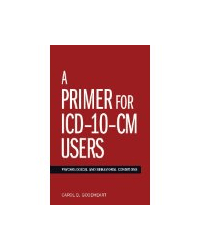“A Primer for ICD-10-CM Users: Psychological and Behavioral Conditions”

“A Primer for ICD-10-CM Users: Psychological and Behavioral Conditions”
By Carol D. Goodheart, Ed.D.
American Psychological Association
Washington D.C., 2014
Slim book is thick with resources for psychologists
Reviewed by Joseph Ricciardi, PsyD, BCBA-D, CBIS
By now, most U.S. psychologists are aware that on Oct. 1, 2015 they will need to be using the ICD-10-CM diagnostic codes for HIPAA compliant reimbursement and documentation.
For some, this change is considered a mundane re-coding task. Fortunately, “A Primer for ICD-10-CM Users” by psychologist Carol D. Goodheart, Ed.D., explains the importance of the change and should motivate psychologists to view this as a valuable, clinically important transition.
From the beginning, the book’s intent is to admonish psychologists to view the new system as more than simply “new codes.” Indeed, the transition to ICD-10 marks the globalization of U.S. clinical psychology.
Nearly 95 percent of the world’s health professionals are already using ICD-10 (and in fact, are poised to transition to ICD-11 soon). Joining the system realigns U.S. behavioral health with epidemiology and research across the globe. For the practitioner, the system will immediately enable clinicians to better understand diagnoses in patients coming from other countries of origin, and may guide a more culturally responsive use of diagnosis as well.
In chapter 1, the author explains the importance of this change and how American psychological practice will benefit. She then provides an overview of the development of the ICD from its early origins in the late 1800’s to the World Health Organization, and then to the present day (chapter 2).
The combination of “Why we should care?” and “Where did this come from?” presented succinctly in these chapters forms a solid foundation for the material that follows.
The author’s expressed aim is to help clinicians adapt comfortably to the coming transitions. To achieve this goal, the writing is brief and pragmatic, but sensitive to the demands of making change.
For example, she comprehensively describes the hierarchical organization of the ICD-10-CM, but she reassures readers that there will probably be a more limited number of codes to be concerned about because practice specialization means clinicians routinely use only about eight different codes.
The change is not as daunting as it seems. Along with much useful explanation and advice, the book recommends numerous Web sites for downloadable documents and conversion tools for practitioners. Primed by this book, readers will be ready to take advantage of these freely available resources.
Perhaps the strongest and most important guidance focuses on classification itself as an essential component of case formulation.
In chapter 4, the author provides a brief but cogent overview of case formulation as the process by which case features are integrated to explain cause, precipitant and influencing factors of a given presentation.
In practice, co-morbidities are the rule, and complicating features are more common than not. A treatment is tailored to the specifics of the case, not reactive to a particular classification. Diagnosis is an important component of the process, but not sufficient by itself. Clinical judgment is more critical, and judgment may be applied where codes fall short.
“Overall, rigidity seems to be the enemy of good case conceptualization,” she writes. This chapter is one of the book’s strongest and will be a valuable read for practitioners and graduate students.
Overall, I found the book to be a very readable and clinically useful resource for psychologists wishing to ramp up for the transition to ICD-10-CM.
The author is a busy practitioner herself, so she is not about to bog down a peer with word counts. She emphasizes practical implementation. However, the book carries throughout an important message about classification as a part of best practice for the clinician and also for the field itself.
Joseph N. Ricciardi, PsyD, ABPP, BCBA-D, CBIS is assistant vice-president and director of clinical services at Seven Hills NeuroCare.
Learn more about the book: A Primer For ICD-10-CM Users: Psychological and Behavioral Conditions (Applications of ICD-10 and ICD-11 to Psychology)
